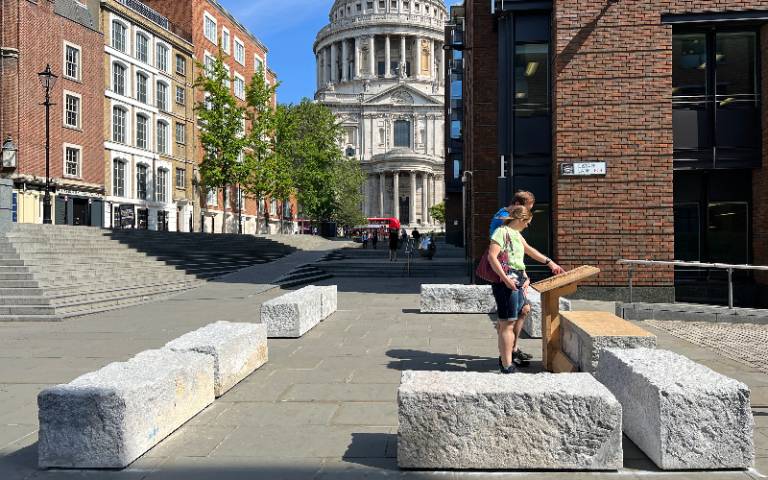Victoria Embankment stones repurposed for new circular materials experience
21 June 2023
To prompt discussion about the circular economy and celebrate the role of stone in the City of London’s creation, 58 granite blocks from London’s Victoria Embankment on the Thames have been relocated throughout the City, as part of a project designed by UCL architects.

Titled ‘From the Thames to Eternity,’ the stones are placed at seven sites across the City including by St Bartholomew’s Hospital, the Millennium Bridge, St Paul’s Cathedral and Smithfield Market. They are arranged to provide locations for people to rest and gather, as well as to reflect on the history of the City and the role that material re-use has played throughout.
The temporary stone re-use project was designed by Matthew Barnett Howland (UCL Bartlett School of Architecture and CSK Architects) and Oliver Wilton (UCL Bartlett School of Architecture).
Matthew Barnett Howland said: “These granite stones from the Thames River wall are remarkable pieces of natural history and cultural heritage, originally quarried in the 19th century, and now available for re-use due to the Thames Tideway Tunnel sewer project."
Oliver Wilton said: "By storing and displaying these stones across the City of London, we want to highlight the long tradition of stone re-use in the City and provoke discussion on the need to move to a more circular model in general.”
London is built on land composed of clay and gravel, with no native stone. Blocks such as the ones on display have always been quarried elsewhere in the country, or elsewhere in the world, and transported to the City, as far back as Roman times. This natural scarcity made stones such as these a precious commodity, and many stone blocks have been reused time and time again in different structures.
The project designers hope that visitors will reflect on this history of material re-use and glean insight into the historic role and future importance of reusing and recycling materials. Their aim is to provoke public discussion about material lifespan, cultural heritage and the circular economy, an idea that advocates for re-using materials, like these granite blocks, as a means of tackling waste, pollution and climate change. In addition, by retaining London’s resources within London in order to reduce imported materials, they feel they can help to enrich the inhabitation of the city.
The stones on display were originally quarried in the 19th century, mainly in Cornwall and Scotland, for use in Victorian-era civil engineer Joseph Bazalgette’s Thames River wall at Victoria Embankment. Completed in 1875, the public works project installed more than 1,000 miles of sewer lines throughout London. It was the first major attempt to clean up the Thames and modernise London’s sewer system to prevent a repeat of the notorious Great Stink in 1858.
The 58 granite blocks in the project have been removed from the embankment river wall to build the new Thames Tideway Tunnel sewer. They have been gifted to the project by Westminster City Council, enabled by Tideway. After a thorough cleaning, they have been installed around the City on a temporary basis as part of the “From The Thames to Eternity” project, before moving on to their next long-term use in King Edward Square, a forthcoming new public square adjacent to Christchurch Greyfriars Church Garden.
Graham Packham, Chairman of the City of London’s Streets and Walkways Committee, said: “The Thames to Eternity project is a brilliant initiative that combines our commitment to delivering a thriving arts and culture scene for all to enjoy, with our goals for a sustainable, net-zero City by 2040. Events like these will enliven the City’s streets and venues, encouraging audiences to experience this part of London in a new way.
“I would like to encourage everyone to visit the installations if they get the chance. The stones have acquired a rich character that reflect 150 years of weathering and tidal movement, adding a layer of physical history to their cultural heritage.”
Links
- From the Thames to Eternity website
- Matthew Barnett Howland’s academic profile
- Oliver Wilton's academic profile
- The Bartlett School of Architecture, UCL
- The Bartlett Faculty of the Built Environment, UCL
Image
- Two pedestrians read the inscription accompanying the stone installation at Peter's Hill.
Credit: Oliver Wilton
Media Contact
Mike Lucibella
- E: m.lucibella [at] ucl.ac.uk
 Close
Close

